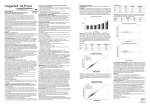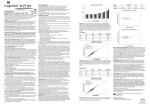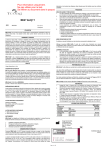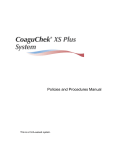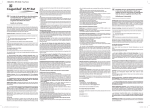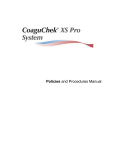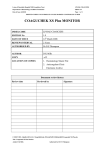Download Roche CoaguChek XS System User manual
Transcript
US Cat. No. 04625315160 48 Test Strips, 1 Code Chip This is a CLIA waived system. These test strips are to be used with the CoaguChek XS System. A certificate of CLIA waiver is required to perform the test in a waived setting. For more information on how to obtain a certificate, visit www.cms.hhs.gov/clia. Purpose The CoaguChek XS System is intended for use by professional healthcare providers for quantitative prothrombin time testing for the monitoring of warfarin therapy. The CoaguChek XS System uses fresh capillary or nonanticoagulated venous whole blood. Caution: These test strips are for use outside the body only. Do not eat the test strips. Before You Start Testing If you are new to the CoaguChek XS System, watch the CoaguChek XS System Video and read the CoaguChek XS System Getting Started guide before testing. Storing the Test Strips Store the test strips in their container, with the cap closed. You can store the test strips at room temperature or in the refrigerator (2 to 30°C or 36 to 86°F). When stored properly, the test strips can be used up until the expiration date printed on the test strip container. Dispose of the test strips if they are past their “Use By” date. Handling the Test Strips When you are ready to test, remove 1 test strip from the container. Do not open a vial of test strips or touch a test strip with wet hands or gloves. This may damage the test strips. Close the container tightly. You must use the test strip within 10 minutes of removing it from the container. Otherwise, you may get an error message and you will have to repeat the test. Sample Collection and Preparation The steps that follow apply to collecting a blood sample from a fingerstick. Optionally, you may use a capillary tube to collect the fingerstick blood sample. You may also use the CoaguChek XS System to test venous blood. See Optional Testing Methods in the CoaguChek XS System User Manual for more information. When collecting any type of sample, follow universal blood collection precautions and guidelines. Step 1: Getting Ready to Test Gather supplies: • CoaguChek XS Meter • CoaguChek XS PT Test Strip • Test Strip Code Chip • Lancet (Follow the manufacturer’s instructions to prepare the lancet for use.) If you are using test strips from a new, unopened box, you will need to change the Test Strip Code Chip. The 3-number code on the test strip container must match the 3-number code on the code chip. To install the code chip, follow the instructions in the Code Chip section of the CoaguChek XS System User Manual. Put the meter on a flat surface, like a table or countertop, that will not vibrate or move during testing, as this can result in an error message. Step 2: Testing Blood from a Fingerstick Getting a Good Drop of Blood Increasing the blood flow in the finger will help you get a good drop of blood. Before you lance the finger, try the following techniques until you see that the fingertip has good color: • Warm the hand by having the patient hold it under his or her armpit, use a hand warmer, and/or wash the hand with warm water. • Have the patient hold his or her arm down to the side, so that the hand is below the waist. • Massage the finger from its base. • If needed, immediately after lancing, gently squeeze the finger from its base to encourage blood flow. Procedure 1. Wash the patient’s hands with warm, soapy water or wipe the finger with alcohol. Allow the patient’s finger to dry completely before performing the fingerstick. 2. Take a test strip out of the container. Close the container tightly. 3. Insert a test strip as far as you can. The meter turns on. 4. Confirm that the number displayed matches the number on the test strip container, then press M. If the numbers are different, make sure you are using the code chip that came with the test strips you are using. 5. An hourglass appears as the meter warms up, which takes about 30 seconds. 6. When the meter is warmed up, a flashing test strip and blood drop symbol appear and the meter begins a countdown. You have 120 seconds to apply blood to the test strip. 7. Use the lancet to perform a fingerstick. 8. Apply 1 drop of blood to the top or side of the target area. You must apply blood to the test strip within 15 seconds of lancing the finger. 9. Do not add more blood. Do not touch or remove the test strip when a test is in progress. 10. The result appears in about 1 minute. Record the result. 11. Properly dispose of the used lancet and test strip. 12. Turn the meter off. If you need to redo a test, use a new lancet, a new test strip, and a different finger. Technical Information How the Test Works The CoaguChek XS PT Test, used as directed with the CoaguChek XS Meter, will provide an electrochemical measurement of prothrombin time following activation of blood coagulation with human recombinant thromboplastin. In simple terms, blood works with the chemicals in the test strip to make a small electric current in the test strip that measures blood-clotting time. Contents of the Test Strip The test strip contains reagent (human recombinant thromboplastin 1.5 U), as well as stabilizers, preservatives, and additives. Limitations of Procedure • The CoaguChek XS PT Test uses only fresh capillary or non-anticoagulated venous whole blood. Plasma or serum cannot be used. • Use only plastic syringes without anticoagulants or additives. Glass tubes or syringes must not be used. • The blood drop must be a minimum of 10 µL in volume. Low sample volume will cause an error message. • Never add more blood to test strip after test has begun or perform another test using the same fingerstick. • When a patient is on intravenous infusion therapy, do not collect sample from arm receiving the infusion line. • Hematocrit ranges between 25-55% do not significantly affect test results. • Testing performed with the following in vitro spiked samples or native blood samples (Triglycerides) indicated no significant effect on test results: • • • • • Bilirubin up to 30 mg/dL Lipemic samples containing up to 500 mg/dL of triglycerides Hemolysis up to 1000 mg/dL The results are unaffected by heparin concentrations up to 0.8 U/mL. The CoaguChek XS PT Test is insensitive to low molecular weight heparins (LMWH) up to 2 IU anti-factor Xa activity/mL. • The presence of anti-phospholipid antibodies (APAs) such as Lupus antibodies (LA) can potentially lead to prolonged clotting times, i.e., elevated INR values. A comparison to an APA-insensitive laboratory method is recommended if the presence of APAs is known or suspected.1 • In rare cases, patients with long clotting times (>8 INR) may receive an “ERROR 7” message on the meter display. If this error message appears again when the test is repeated, the result must be checked using another method. Expected Results The CoaguChek XS Meter displays test results in units equivalent to laboratory plasma measurements. Results may be displayed in the International Normalized Ratio (INR=(PT/Mean Normal PT)ISI), seconds, and % Quick (a unit used mainly by healthcare professionals in Europe). Each lot of test strips is calibrated to a reference lot that is traceable to the WHO International Reference Preparations. Normal INR levels vary from person to person. When the CoaguChek XS PT Test was performed using the CoaguChek XS Meter on 121 normal, healthy, warfarin-free individuals using venous and capillary samples, 97% of the INRs ranged from 0.9 to 1.1. For the purpose of providing universal INR results, the Mean Normal Prothrombin Time (MNPT) has been established as 12 seconds for healthy volunteers and the International Sensitivity Index (ISI) for the system has been established as 1. The physician must determine the best INR level depending on the reason for anticoagulant treatment and how each individual responds to treatment (based on Prothrombin Time). Each physician should establish expected values for his or her patient population or individual patients. Differences in reagents, instruments, and pre-analytical variables can affect prothrombin time results. These factors should be considered when comparing different prothrombin time test methods.2 Unusual Results If the meter displays an error message, refer to the Error Messages section of the CoaguChek XS System User Manual. If the meter displays an unusual test result (other than an error message), check the following items: • Is the correct code chip in the meter? The 3-number code on the test strip container must match the 3-number code on the code chip. • Is the meter set up with the correct date and time? Certain drugs may affect results by affecting warfarin pharmacology. The potential effect of a drug interaction with warfarin or the effect of underlying diseases (e.g., liver disease, congestive heart failure) must be considered when interpreting a result. Also, changes in the patient’s diet can cause unusually low or high results. Any unusual result should always be followed up with appropriate coagulation studies and inquiries to define the cause of the unusual result. If the result does not match the clinical symptoms, repeat the patient test to rule out procedural error. Performance Characteristics Measuring Range: The CoaguChek XS System has a reportable range of 0.8 to 8.0 INR. Sensitivity: The CoaguChek XS PT Test is sensitive to various clotting factors as determined by in vitro tests. Single factor depleted plasma was combined with a normal plasma pool to produce a series of diluted plasma samples. These plasma samples were then tested using three representative lots of the CoaguChek XS PT Test across sixteen CoaguChek XS meters. The results, as seen in the graph below, represent the typical CoaguChek XS PT Test sensitivity to Factors II, V, VII, and X. Accuracy: 710 venous samples were collected from 355 outpatients at three external sites. The INR of each sample was compared to the INR of a venous plasma sample measured on a Sysmex Analyzer using Dade Innovin (ISI = 1.02). The patient clinical conditions included (number of patients): normal - not on warfarin (62), atrial fibrillation (174), valve replacement (35), stroke/TIA (28), DVT (16), other heart-related disorders (4), other clotting disorders (6), other (30). Venous Data: N Slope Intercept Correlation Site 1 232 1.129 -0.10 0.983 Site 2 230 1.111 -0.11 0.971 Site 3 248 0.984 -0.03 0.986 All 710 1.034 -0.02 0.974 Venous Data from All Sites 710 Samples from 355 Patients 9 CoaguChek XS Factor Sensitivity y = 1.034x - 0.02 Slp Cl (1.017, 1.053) Int Cl (-0.04, 0.01) Correlation = 0.974 8 3.0 7 2.5 CoaguChek XS INR ® 2.0 INR CoaguChek XS PT Test 1.5 1.0 6 5 4 3 2 0.5 1 0.0 100 75 50 25 12.5 6.25 % Factor Factor II Factor V Factor VII Factor X ....... ....... Normal Range 0 0 1 2 3 4 5 6 7 8 9 Dade Innovin INR 0 4625706001(01) V1/R1 (black) – 2006-09 Accuracy: 700 capillary samples were collected from 357 outpatients at three external sites. Capillary blood samples were assayed on the CoaguChek XS meter with the CoaguChek XS PT Test and venous plasma samples were measured on a Sysmex Analyzer with Dade Innovin (ISI = 1.02) The results comparison is as follows: N Slope Intercept Correlation Site 1 230 1.111 -0.10 0.973 Site 2 229 1.081 -0.068 0.979 Site 3 241 0.952 0.02 0.985 All 700 1.006 0.032 0.971 .4 .2 1. Moll, S and Ortel, TL. “Metering Warfarin Therapy in Patients with Lupus Anticoagulants.” Annals of Internal Medicine 1997; 127: 177-185. 2. Loeliger EA, van den Besselaar AMHP and Lewis SM., “Reliability and Clinical Impact of the Normalization of the Prothrombin Times in Oral Anticoagulant Control.” Thromb Haemostas, 1985; 53: 148-154. -.2 -.4 -.6 Return Policy 0 1 2 3 4 5 Mean of Replicates 6 7 8 Whole Blood Precision for Capillary Blood If there is a problem with the CoaguChek XS PT Test Strips, you may be asked to return them, along with the Test Strip Code Chip, to Roche Diagnostics. Before returning, call Roche Diagnostics Technical Service Center at 1-800-428-4674. You will be mailed a return authorization label which must be put on the shipping carton. Additional Information 6 .8 5 .6 The CoaguChek XS System User Manual contains more information. If you still have questions, call Roche Diagnostics Technical Service Center at 1-800-428-4674, 24 hours a day, 7 days a week. .4 Limited Warranty 4 3 2 1 0 0 1 2 3 4 5 6 7 8 9 Dade Innovin INR Roche Diagnostics warrants that your CoaguChek XS PT test strips will be free from defects in materials and workmanship until the product expiration date printed on the label if the test strips are used and stored in the manner described in this package insert and in your CoaguChek XS System User’s Manual. If, prior to the expiration date of the test strips, there is a defect in materials or workmanship, Roche Diagnostics will replace the test strips free of charge. Your sole and exclusive remedy with respect to the strips shall be replacement. Any warranty claim should be directed to the Roche Diagnostics Technical Service Center at 1-800-428-4674. .2 .0 -.2 -.4 -.6 -.8 Precision: Whole blood precision was determined for venous and capillary blood from sample duplicates collected at three sites. The following charts represent whole blood precision for venous and capillary blood. -1.0 SHALL ROCHE DIAGNOSTICS BE LIABLE TO THE PURCHASER OR ANY OTHER PERSON FOR ANY INCIDENTAL, CONSEQUENTIAL, INDIRECT, SPECIAL OR PUNITIVE DAMAGES ARISING FROM OR IN ANY WAY CONNECTED WITH THE PURCHASE OR USE OF THE TEST STRIPS. NO WARRANTY OF MERCHANTABILITY OR FITNESS FOR A PARTICULAR PURPOSE, IF ANY IS IMPLIED FOR THE SALE OF THE TEST STRIPS, SHALL EXTEND FOR A LONGER DURATION THAN THE EXPIRATION DATE OF THE TEST STRIPS. References .0 1.0 Difference Between Replicates CoaguChek XS INR 7 .6 -1.0 y = 1.006x + .032 Slp Cl (0.990, 1.023) Int Cl (-0.01, 0.06) Correlation = 0.971 8 The CoaguChek XS System has quality control functions integrated into the meter and test strips, so you never have to run quality control tests with liquid quality controls. The meter automatically runs its own quality control test as part of every blood test. For more information about the built-in quality control functions, see the CoaguChek XS System User Manual. -.8 Capillary Data from All Sites 700 Samples from 357 Patients 9 Built-In Controls and Diagnostics .8 Difference Between Replicates Capillary Data: Whole Blood Precision for Venous Blood 1.0 0 1 2 3 4 5 Mean of Replicates 6 7 8 THE ABOVE WARRANTY IS EXCLUSIVE OF ALL OTHER WARRANTIES, AND ROCHE DIAGNOSTICS MAKES NO OTHER WARRANTIES, EXPRESS OR IMPLIED, INCLUDING WITHOUT LIMITATION THE IMPLIED WARRANTY OF MERCHANTABILITY OR FITNESS FOR A PARTICULAR PURPOSE. IN NO EVENT The following U.S. patents have been granted or are pending for the CoaguChek XS System (meter and test strips): 6,662,439; 7,073,246; 2005/0103624; 6,881,378; 6,207,000; 2005/0214171; 2005/0123441; 6,645,368; 2004/0157339; 2005/0129574; 2005/0135968 COAGUCHEK is a trademark of Roche. ©2006 Roche Diagnostics. All rights reserved. Made in Germany Manufactured by: Roche Diagnostics GmbH D-68298 Mannheim www.roche.com www.coaguchek.com " Distributed in the U.S.A. by: Roche Diagnostics 9115 Hague Road Indianapolis, IN 46256 0 4625706001(01) R1 (black)



